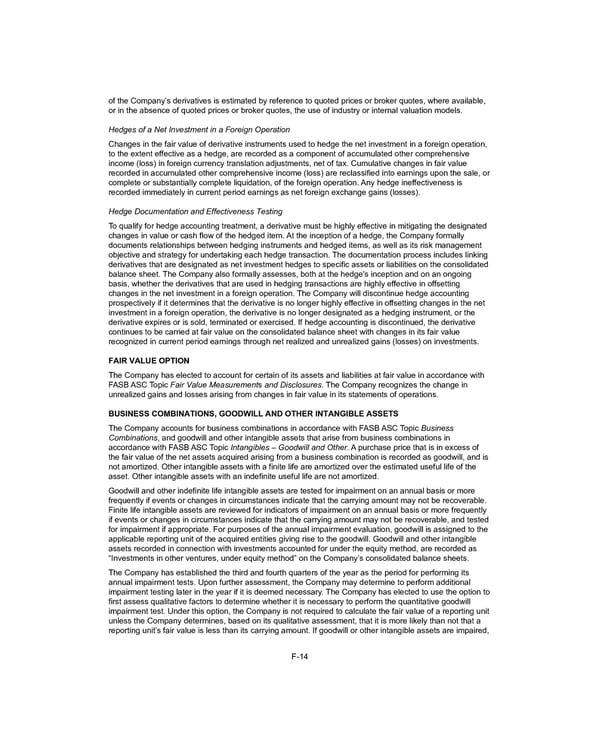of the Company’s derivatives is estimated by reference to quoted prices or broker quotes, where available, or in the absence of quoted prices or broker quotes, the use of industry or internal valuation models. Hedges of a Net Investment in a Foreign Operation Changes in the fair value of derivative instruments used to hedge the net investment in a foreign operation, to the extent effective as a hedge, are recorded as a component of accumulated other comprehensive income (loss) in foreign currency translation adjustments, net of tax. Cumulative changes in fair value recorded in accumulated other comprehensive income (loss) are reclassified into earnings upon the sale, or complete or substantially complete liquidation, of the foreign operation. Any hedge ineffectiveness is recorded immediately in current period earnings as net foreign exchange gains (losses). Hedge Documentation and Effectiveness Testing To qualify for hedge accounting treatment, a derivative must be highly effective in mitigating the designated changes in value or cash flow of the hedged item. At the inception of a hedge, the Company formally documents relationships between hedging instruments and hedged items, as well as its risk management objective and strategy for undertaking each hedge transaction. The documentation process includes linking derivatives that are designated as net investment hedges to specific assets or liabilities on the consolidated balance sheet. The Company also formally assesses, both at the hedge's inception and on an ongoing basis, whether the derivatives that are used in hedging transactions are highly effective in offsetting changes in the net investment in a foreign operation. The Company will discontinue hedge accounting prospectively if it determines that the derivative is no longer highly effective in offsetting changes in the net investment in a foreign operation, the derivative is no longer designated as a hedging instrument, or the derivative expires or is sold, terminated or exercised. If hedge accounting is discontinued, the derivative continues to be carried at fair value on the consolidated balance sheet with changes in its fair value recognized in current period earnings through net realized and unrealized gains (losses) on investments. FAIR VALUE OPTION The Company has elected to account for certain of its assets and liabilities at fair value in accordance with FASB ASC Topic Fair Value Measurement s and Disclosures . The Company recognizes the change in unrealized gains and losses arising from changes in fair value in its statements of operations. BUSINESS COMBINATIONS, GOODWILL AND OTHER INTANGIBLE ASSETS The Company accounts for business combinations in accordance with FASB ASC Topic Business Combinations , and goodwill and other intangible assets that arise from business combinations in accordance with FASB ASC Topic Intangibles – Goodwill and Other . A purchase price that is in excess of the fair value of the net assets acquired arising from a business combination is recorded as goodwill, and is not amortized. Other intangible assets with a finite life are amortized over the estimated useful life of the asset. Other intangible assets with an indefinite useful life are not amortized. Goodwill and other indefinite life intangible assets are tested for impairment on an annual basis or more frequently if events or changes in circumstances indicate that the carrying amount may not be recoverable. Finite life intangible assets are reviewed for indicators of impairment on an annual basis or more frequently if events or changes in circumstances indicate that the carrying amount may not be recoverable, and tested for impairment if appropriate. For purposes of the annual impairment evaluation, goodwill is assigned to the applicable reporting unit of the acquired entities giving rise to the goodwill. Goodwill and other intangible assets recorded in connection with investments accounted for under the equity method, are recorded as “Investments in other ventures, under equity method” on the Company’s consolidated balance sheets. The Company has established the third and fourth quarters of the year as the period for performing its annual impairment tests. Upon further assessment, the Company may determine to perform additional impairment testing later in the year if it is deemed necessary. The Company has elected to use the option to first assess qualitative factors to determine whether it is necessary to perform the quantitative goodwill impairment test. Under this option, the Company is not required to calculate the fair value of a reporting unit unless the Company determines, based on its qualitative assessment, that it is more likely than not that a reporting unit’s fair value is less than its carrying amount. If goodwill or other intangible assets are impaired, F-14
 2021 Annual Report Page 156 Page 158
2021 Annual Report Page 156 Page 158